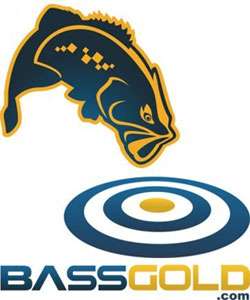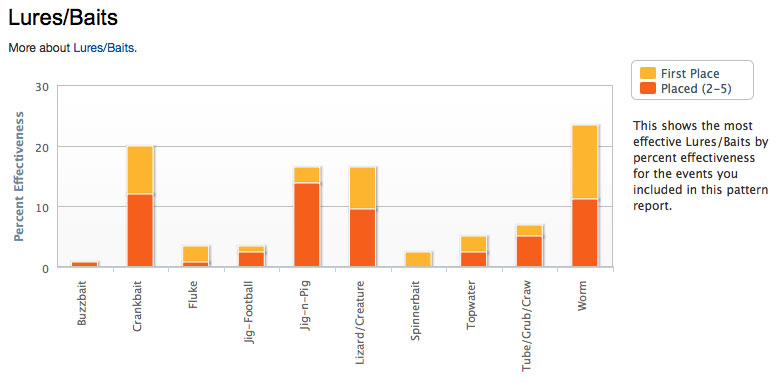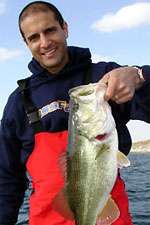
Elite Series pros are back on the water this week, this time at Toledo Bend, the huge, well-known tournament impoundment that straddles a big chunk of the Texas-Louisiana border.
A lake that size can be tough to decipher, even for Elites. As former Elite pro Ken Cook said, “When looking at a huge reservoir like T-Bend, you can be intimidated by the size of the playing field. To make the situation more manageable, it’s helpful to have a history of data, and that’s where BassGold comes in.”
When it comes to patterning fish, it’s important to note that T-Bend is the first lake of its type on the Elite schedule this year: a lowland reservoir. So far, Elite pros have only fished natural lakes/rivers (Florida) and upland reservoirs (Missouri and Tennessee). A different “water type” – how BassGold classifies lakes and rivers – is a big deal.
In fact, fishing experience by water type is often more important than specific water body or even in-state experience, especially when you’re talking about Elite pros, who fish different lakes all the time. Take Brandon Palaniuk, for example. He’d never seen Bull Shoals before, but won there – and was comfortable fishing there – in part because he’s familiar with upland reservoirs.
The bottom line when it comes to patterning bass is that lakes of the same water type fish similarly, while different water types don’t. With that, here’s what BassGold.com tells us about patterning fish this time of year on Toledo Bend.
Macro Factors
In BassGold, “Macro Factors” are generally the locations on a lake where fish have been caught. In this case, there are just four words you need to know this time of year on T-Bend: “main lake offshore structure.” Main lake offshore structure includes offshore grass. That will be no surprise to the Elite pros or to anyone remotely familiar with the lake.
Cook described it further saying, “With BassGold showing almost 80 percent of high finishers using offshore structure or main lake points, there’s little benefit in looking at other parts of the lake. This is where BassGold really pays back the cost. It puts you into the best part of a huge lake without having to spend extra time and gasoline checking out other sections.”
What’s interesting is that when you manipulate the Macro Factors bar graph in a BassGold Toledo Bend “Pattern Report,” you see that creek channel structure is second-most-important for wins, while main lake points are second-most-important for second through fifth finishes.
Seeing evidence that winners and runner-ups do different things never gets old!
Habitat Factors
Think of Toledo Bend and you think of grass. Acres and acres of what BassGold calls “submergent veg,” meaning underwater grass.
Sure enough, submergent veg is the biggest factor in first through fifth-place wins, but again there’s a split between winners and second through fifth finishers. It boils down to this: More wins involve wood than grass, while the opposite is true for second through fifth finishes.
Ken notes that if you can find both on the same structure, great: “When combined, these two types of habitats are even more important.”
Lures/Baits
As usual, BassGold shows that winners and placers (second through fifth) use various baits. Ken said, “Many lures will work well when put into the correct habitat. The key is to choose lures that will work effectively in the chosen habitat.”
The BassGold Pattern Report for T-Bend this time of year shows that “worm,” “crankbait,” “lizard/creature” and “jig-n-pig” are the most-often used baits, in that order.
And, yet again, there’s a split. Manipulating the “lures/baits” graph in the Pattern Report shows that worms factor almost twice as much as crankbaits in wins, while jig-n-pigs and crankbaits factor more in second through fifth finishes than worms. By the way, “worms” in this case means mostly 10-inch-plus worms, not Senkos, centipedes, etc.

Ken said that if he were fishing this tourney, he’d “look strongly at using Texas rigged plastic worms, especially big ones, and deep crankbaits because they’re most likely lures to produce winning catches.”
Winning Weight
Average daily weights on the “Weights By Month” graph in the Pattern Report shows a cluster of winning and placing weights that range from the low teens to the low 30s per day. Seeing this in graph form enables you to quickly toss out the outliers, leaving a most-likely scenario of low 20s per day to win.
In saying that, you have to consider the fact that these are Elite pros, meaning:
- A couple of times this year, winners of Elite events have been on the way high side of the averages.
- BassGold.com shows what has worked in the past and thus what is likely to work this time, but current conditions and the amazing ability of Elite pros to find fish where thousands of other anglers haven’t need to be factored in when the event starts.
I should also mention that a quick surf through BassGold’s pattern details for tournaments involved in compiling this Pattern Report turns up helpful details – like the fact that redbug is a hugely popular color this time of year.
In other words, what you find in BassGold is “gold,” and there’s more “gold” in how you apply it with your own fishing knowledge and experience.
With a database of thousands of tournament patterns covering hundreds of lakes, BassGold.com – a B.A.S.S. partner – is the ultimate bass patterning tool. Right now, you can get $5 off the BassGold.com annual registration price when you click here and use code BFB001 when you sign up. Don’t forget to use the code! Note that BassGold offers a three-day free trial.





